#styraphant
Explore tagged Tumblr posts
Text
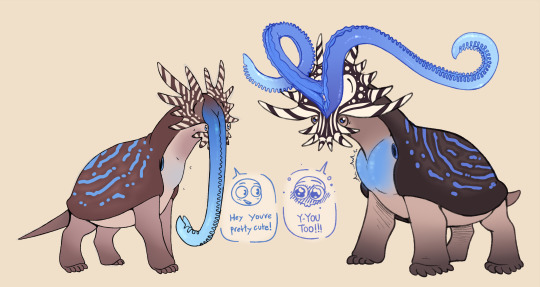
Want to work on a good expression sheet for styraphants but got distracted drawing flustered flirting. Also decided they talk through rumbling air within an inflatable sack in their chest! It's also how they blush because how cute.
3K notes
·
View notes
Text
Just some doodles for spectember
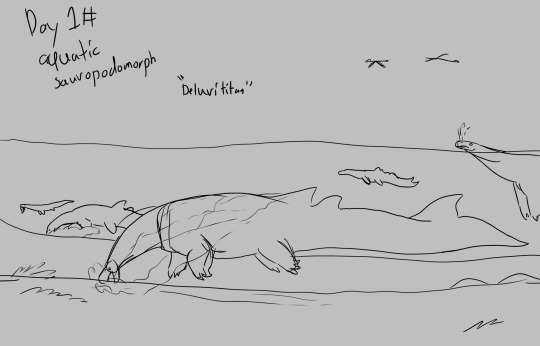



Styraphant by @extrajigs
#my artwork#speculative biology#Styraphant#Spec bio#xenobiology#sauropods#sophont#dinosaurs#earkonia
23 notes
·
View notes
Text
Utter perfection. I don't know how u did it but i am HONORED. friggin BEAUTIFUL DUDE!! So SICK!!!!!!
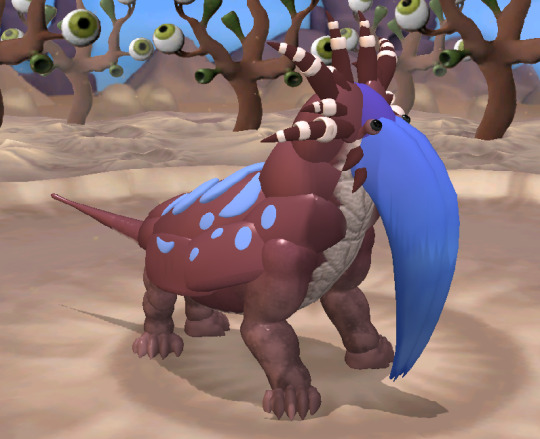
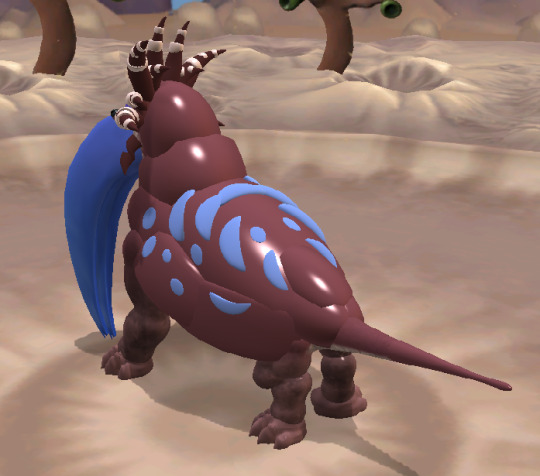
i made @extrajigs' styraphants in spore [2008]

716 notes
·
View notes
Text
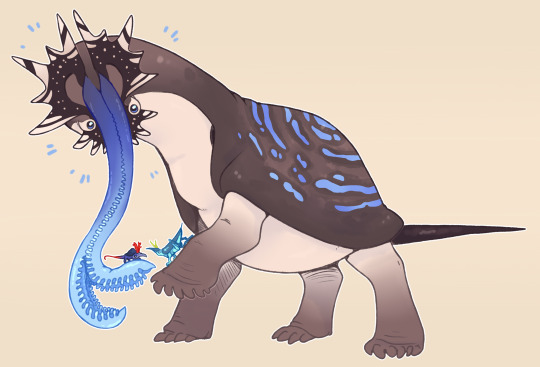
NEW ALIEN AGAIN! This one I wanted to stick to being more Earth inspired, connecting with my roots. I'm calling 'em Styraphants cause they're mostly a mix of styracosaurus, elephant, and mollusk of course. Trying to make a quad walking sophont always lends to kind of a centaur-ish body plan, so tried to think outside the box for appendages this go around. They've got a pair of trunk tentacles around their mouth that they use as their hands, which have a fleshy 'zipper' to slot together at rest. They also smell/taste with them so gloves are a very popular purchase.
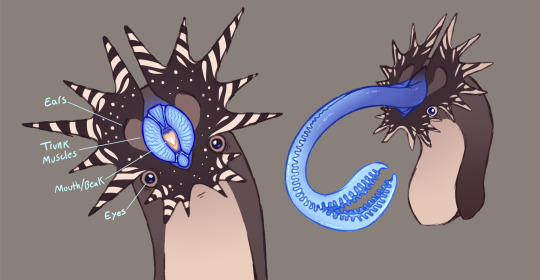
Oh also! Their eyes are on little stalks that peak out around their frill, they can hide them away if scared. Also all the fellas pictured here are gals! They have a male/female system in keeping with the Earthling megafauna theme.
#art#worldbuilding#speculative biology#spec bio#styraphant#alien#xenobiology#fleshing out existing critters<makin new ones#it is a curse
3K notes
·
View notes
Text

Styraphant ethnicity BIG POST! Basically just going over the main 'flavors' that all styraphants kind of fall into. More detail below the cut!
They can all interbreed and are the same species, but have a lot more genetic variation than human populations on Earth! There are about 6 main 'morphs', but that being said individuals with varied lineages may be a little hard to pin down. When in doubt the shape of ones crest is where most will look when trying to assume! Because that IS where most of the variation resides. Big list inbound.

Star. These are the dudes I've been drawin so far. They tend to inhabit around the center of their planets largest continent, in the more tropical zones. So like to live in wooded areas and lush vegetation.
Flame. These guys are named for the upswept tines on their crest. They are the most Northernly, enjoying mostly temperate climates and migrating as the seasons change to avoid chillier weather.
Fan. These guys are FUN. With large webbed tines on the crests of both males and females. They are darker due to their hot, arid home, so typically built to avoid sunburn.
Scallop. These guys are named because the edges of their crested are, in fact, scalloped. They range from temperate to tropical climates, tending to stick to places on the soggier side.
Disk. These guys have completely smooth crests! They are also the smallest variety, mostly due to their more seaborne nature. They have the widest range of climates and tend to move around the most by a wide margin.
Spade. These have a spade shaped face, obviously, with two large tines pointing directly upward. They are found in the colder, Southern continent, the only variety not found on the mainland. Their thickset frame helps them put up with the cold year round.
This is the gist! They cover a wide variety of crest and body type in these groups as they are pretty different!

Most differences come from the different regions each population has settled in as I'm also thinking that they are an older species. So they've had time to become more sculpted by their environments. They get along pretty well though, like I'm thinking it's odd to not associate with each other!
1K notes
·
View notes
Text
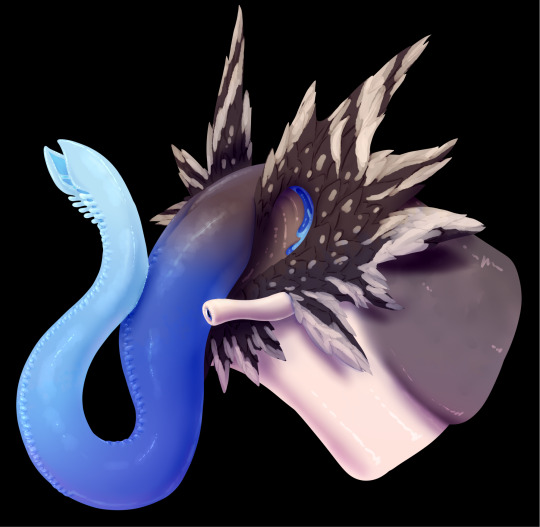
did a more 'realistically' rendered styraphant for a lil discord challenge. thinking they have a rougher 'layered' texture on the frill kind of like tree bark. like it roughens as it grows until it flakes off? much to think about, i never really thought of it until I had to render it!
#like how SMOOTH their trunk came out!#art#styraphant#speculative biology#spec bio#aliens#xenobiology
886 notes
·
View notes
Text

Styraphant and Caltrops face anatomy breakdown since I got a few questions about it! Info BELOW.
The last common ancestor of the both of them had a mouth of 12 tooth tipped appendages, which I'm just calling mandibles for ease of understanding. Since they are kind of analogous to an actual jaw bone? Their mouth was never involved in respiration tho! They had fleshy lips covering their mouth that they could retract to open up their mandibles and snatch prey. They also had eyestalks! Eyestalks emerge from the back of the head and could be retracted somewhat. In the case of styraphants they really went all in on them lips. The lips have evolved into two large main lobes which form each half of the trunk. I'm reworking the beak inside a bit to be separated into 4 main parts. Each is formed from a fusion of two mandibles, leaving them with technically only 8 in total. Though some individuals may sprout a vestigial tooth or two, kind of like wisdom teeth! Styraphants also retain their eyestalks, their overall build is not too far removed from their common ancestor.
Caltrops went for a more mandible focused route, their lips have reduced into the webbing between each mandible. Which they still retain all 12 of the ancestral condition. Their teeth are quite reduced and are actually pretty large for members of their group. Oh! Their eyes have also compacted from their flying days. The eyestalk is flush to the head and fused with the structure of the eye itself, both are capped by a lens. Caltrops have MUCH better vision than styraphants.
So yeah! I want to do a more in depth post about their evolutionary history. But I need to think about how I wanna do it.
#they are SIMILAR but DIFFERENT#art#speculative biology#spec bio#worldbuilding#xenobiology#aliens#styraphant#caltrop
447 notes
·
View notes
Text
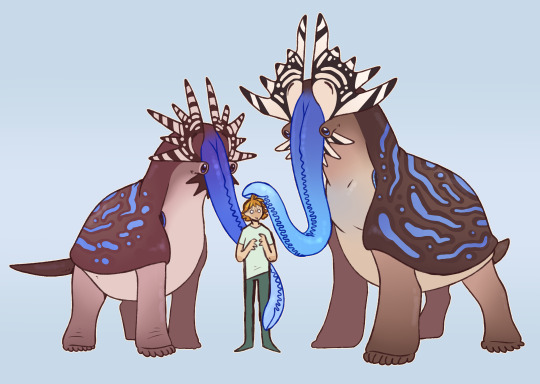
Styraphant average size ref! They're p large. Lady on the left and gentleman on the right! The males are a good percentage larger than the gals and are mainly differentiated by their 'bottom heavy' crest. Which is mainly for show.
#styraphant#art#worldbuilding#speculative biology#spec bio#xenobiology#aliens#to answer all the Qs about their size
2K notes
·
View notes
Text

baby styraphant trapped and awaiting aid
836 notes
·
View notes
Note
Question!! How do Styraphants(?) drink water? :D
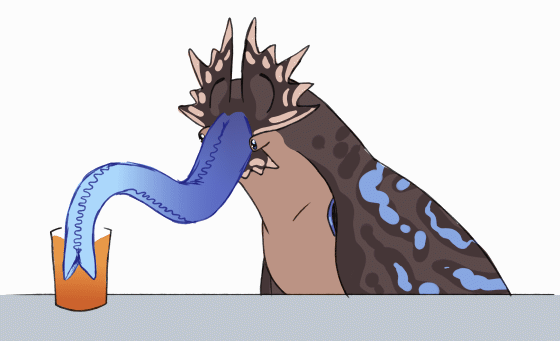
They gotta suck it up through their trunk! I'm thinking they can control the muscles in their trunks to create enough suction for drinking. Gotta keep it zipped though otherwise it can spray out of any gaps, thinking kids will often spring a leak trying to drink properly. Also I gave her broth instead of water if thats okay.
445 notes
·
View notes
Text
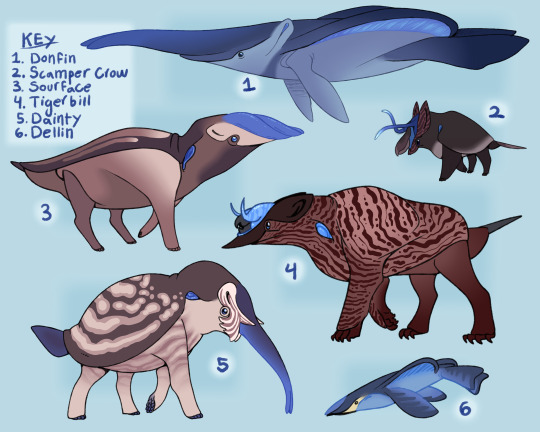
New critters from Styraland! Wanted to branch out into some other beasts hanging out. Infodump on 'em below!
All of these are members of the same family characterized by having a beaked mouth placed between two tentacles. Same as the styraphants! They are pretty varied but I want to have more types of animals so tryna reign them in a little to leave room for others. 1. Donfin- A marine carnivore who occupies a similar niche to a dolphin, using tentacles lined with sharp spines to ensnare small swimming prey. 2. Scamper Crow- A tiny nocturnal hunter who uses their skinny lil tentacles to lure in bugs to crunch up in their oversized beak. 3. Sourface- Possessing a spiraled mouth, these guys like to stick their face into foliage and strip the vegetation bare. Quite fast at it! 4. Tigerbill- An ambush hunter, which I named cause stripes, their tentacles are greatly reduced to avoid them getting in the way of their sharp beak. Though they mainly like to stab with their chin. 5. Dainty- Their tentacles are fused and used to cutely pick seeds out of the leaf litter, the horns on their face are for jabbing each other. 6. Dellin- Another fully marine fella, they travel in large groups mostly along the surface. They can launch themselves out of the water if startled. They are easily startled.
That's the basic info for all of 'em! This is also a lil chart for how they all factor into relatedness in reference to styraphants and each other.
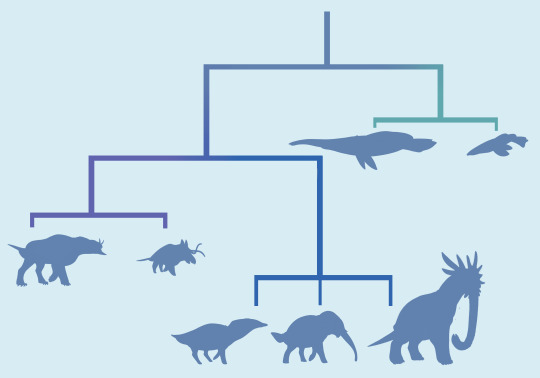
Aside from that I got the BUG POST in the works. Which I am very hype for.
#styraphant#art#worldbuilding#speculative biology#spec bio#xenobiology#aliens#sorry for being sparse been drawin mostly for hire these days#want to do more ALIENS tho
1K notes
·
View notes
Note
Okay but trans sytraphants? How would that work? Like would the crest size change based in HRT or is it a permanent feature once puberty hits? - @thatoddboy
This ask made me THINK! I'm thinking they don't do any messing until puberty is over since the crest does have their brains in it and all, but they can trim back the points of the crest to align to more gender conforming shapes! After that they can also adjust the colors as bio-males crests are colored a lot brighter. Also scent is a very important sense to them! So another option is to change up their scent to better pass. I don't know enough about them yet to know about their hormone situation. They're pretty chill about it tho, there isn't major pressure to physically transition in order to be a dude or gal!
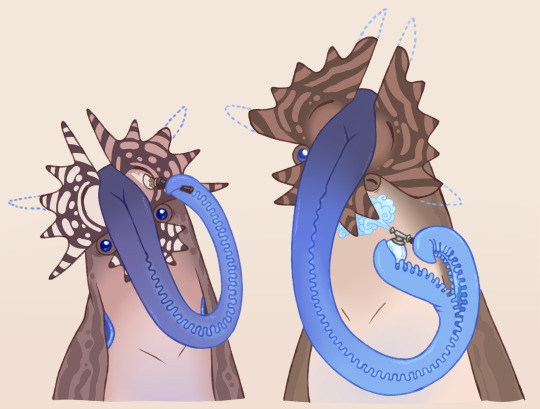
#trans aliens why didnt I think of that#great ask tho!#made me THINK#styraphant#art#speculative biology#spec bio#alien#xenobiology
537 notes
·
View notes
Text
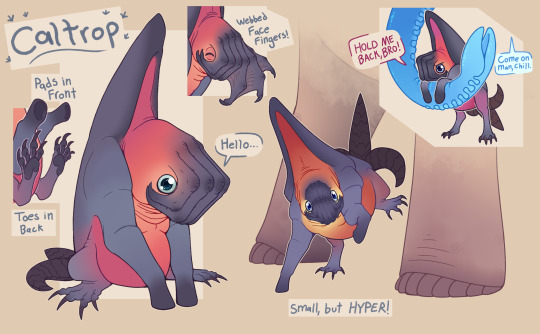
FINALLY finished the fellow sophonts for Styraphant-land. They aren't too closely related to the styraphants and have quiet a few differences. They are small, energized, and hyper carnivorous. Info dump BELOW!
Caltrops live on a mostly tropical continent, with the majority of their range being lush jungle and forests. The continent is pretty new, with the flying ancestors of the Caltrops being some of the first terrestrial creatures to colonize the land. So these guys and their relatives have a pretty intense stranglehold on the niche of megafauna. Caltrops are on the larger side of carnivores there and specialize in catching smaller prey with their creepy face fingers. They also partake in fruits and other treats they can find in the shrubbery.
Or at least they did before they got CIVILIZED. They have a complex and violent history between various peoples and governments that has lead to their current system of shakily aligned states controlling very rigid territories. But things are p chill at the moment! They made contact with the Styraphants a few hundred years ago and they actually have gotten along pretty well, though it is rare to see either living fulltime outside of their native ranges. (See ranges below)
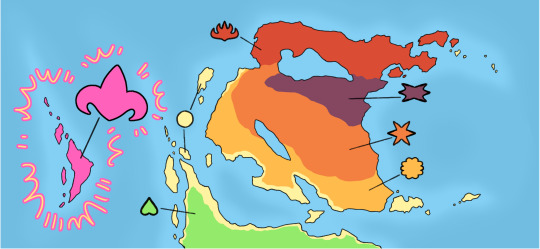
I want to make a more in depth anatomy overview for them, but here are some general notes. They have 'stalk' less eyes, more so the stalk has shortened and become part of the eye itself. They have 6 webbed fingers that cover the majority of their face, including their mouth, nostrils, and secondary fingers. They have NO digits on their front limbs, since they are derived from wings, but they do still have their toesies. That big ass spike above their head is the remnants of their keel, used now for the muscle attachments of their large head. And most importantly is their tail, which like a Styraphant, is grown and dropped to feed their young. Though it is actually the male Caltrop that drops his tail for the kids to eat. Yeah, a good lil STARTER for em. I have another info sheet almost done, but wanted to get them down so I could think on em more.
#caltrop#i wanted CUTE lil aliens#art#worldbuilding#speculative biology#spec bio#xenobiology#aliens#styraphant vaguely there
2K notes
·
View notes
Note
I noticed there was a large archipelago on the styraphant's planet map that appears completely gray, is there any reason for this? Is the island uninhabitable or have the styraphants just not bothered to settle there because it's so far out?
Good eye! It's both because it is kind of far away to get to and because of that, it is inhabited by a different species of sophont! I'm still going back and forth on their design at the moment, but by the time the sytraphants arrive there they are pretty well established. I'm thinking historically, most styraphant populations avoid major conflict by respecting both classical and newly established migratory routes. So a lot of their thought process about em is "well they're using it still and we don't really NEED it.." That isn't to say that there are not SOME small settlements there, but those typically have to be in less than ideal areas or deal with the conflict that comes with moving onto someone else's property.
#tryna get the styraphants tied down before i move onto their planetary siblings#but it is tempting...#but tryna make the new ones still different
43 notes
·
View notes
Text
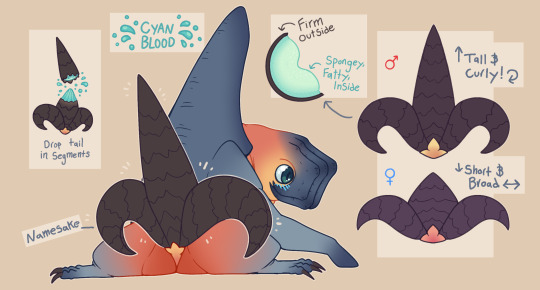
Caltrop expanded lore! Wanted to get into the workings of their booty tails, since I think they're fun. See below the cut for the details!
Caltrop's are named because of their multipronged, caltrop like tail, which is divided into three main lobes. Two curly horns on either side and one long pointy bit in the middle. Males tend to have more substantial tails and this is because tails of caltrops(and styraphants) are used in the feeding of their young. Imagine if instead of making milk, parents just grew a giant wad of condensed fat for babies to munch on. While the mother drops her tail in the case of styraphants, caltrop tails have evolved to be able to break off in sections to allow dad to feed the whole litter piece by piece. When a section slops off the blood supply is cut off and the exposed flesh quickly scabs over before regaining its horn like sheath. I'm thinking new dads will wear a cap over their tail while it heals and to make sure people give up their bus seat for em. Outside of that the tail is also the main method of fat storage, with the curled horns in particular being almost never shed. Tails only begin to grow in during puberty and tend to never stop growing, though they grow quickest during peak 'breeding age' and slow down as they grow older. Caltrops may drop their tails to feed young or if they become ill, overly stressed, malnourished, or damage their hormonal system. Also! Their brightly colored underside extends to their lil booty, because how cute.
402 notes
·
View notes
Text
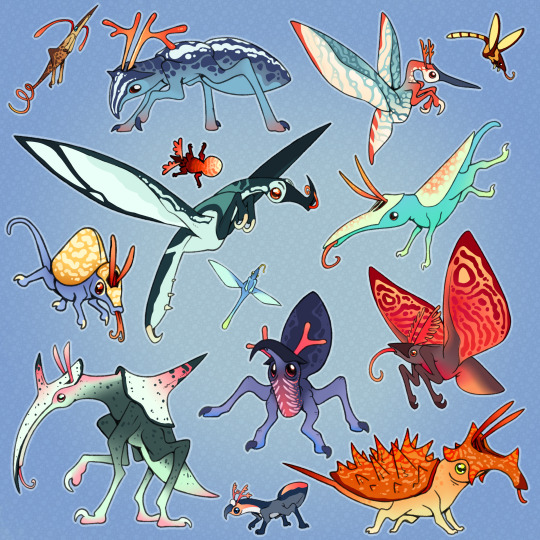
THE LONG PROMISED STYRA-LAND BUGS! Tried to keep them all to one of three body plans; hoppers, creepers, and flutter bys! Also decided they have tiny lil skeletons in em and where the styraphants and other megafauna have blue blood, these are red blooded like us humans. And are more energized for it!
#back from my long journey#with cute bugs no less#art#worldbuilding#aliens#speculative biology#spec bio
898 notes
·
View notes